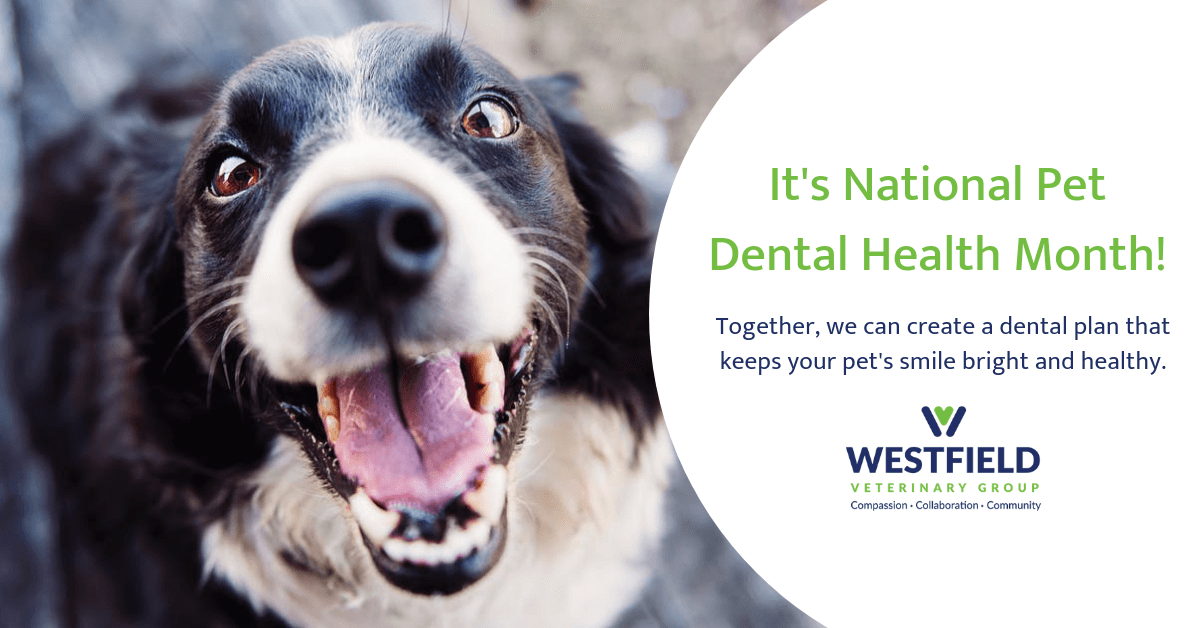-
View Larger Image

You may have heard that February is National Pet Dental Health Month, a reminder to have your pet visit the veterinarian for a full mouth examination and cleaning, if needed. While we encourage good oral health all year long, we too, pay particular attention to this time of year. It’s the perfect time to educate pet parents on the benefits of healthy teeth and gums and more importantly, the potential risks of neglecting your pet’s teeth.
The Facts
Periodontal disease is the most common infectious disease in dogs and cats, affecting 80% of dogs and 70% of cats over 2 years of age,1-3. Unfortunately, on average, only 1 out of every 10 pet owners makes sure their pets’ teeth are cared for regularly.
Although dogs and cats rarely get cavities, the plaque and tartar that forms on their teeth can cause gingivitis and periodontal disease which can lead to tooth decay, bleeding gums, and tooth loss. The bacteria that causes these dental complications can also travel through the bloodstream and eventually damage major internal organs. Plus, periodontal disease can be quite painful.
Do Pets Really Need Anesthesia For Dental Care?
YES. According to the American Animal Hospital Association Dental Care Guidelines for Dogs and Cats, approved and endorsed by the American Veterinary Dental College, dental procedures must be performed under general anesthesia. AAHA goes on to state:
- Anesthesia makes dental evaluation and treatment safer and less stressful for your pet. Animals don’t like to hold still while their teeth are cleaned. Anesthetized dental cleanings allow veterinarians to make a more accurate diagnosis and decrease the chance of complications, like inhaling water or bacteria produced during the cleaning.
- Anesthesia is much safer than you think. AAHA’s guidelines include steps to increase the safety of anesthesia, even in older pets. For example, one trained professional is dedicated to continuously monitoring, recording vital signs, and communicating the findings to the veterinarian. Before anesthesia, your pet will also be carefully screened with blood work and other tests to ensure they are free from underlying disease.
Isn’t Anesthesia Free Cleaning Just as Good?
According to the American Veterinary Dental College, the only certifying organization for veterinarians to become dental specialists, the term anesthesia free dental cleaning is very misleading. At the end of the anesthesia free dental procedure, the outside surfaces of your pet’s teeth may appear visibly whiter. However, there is much more than meets the eye. Because your pet wasn’t under anesthesia, there was no ability to clean beneath the gum line. This is where the bacteria that causes periodontal disease occurs, causing bad breath and extensive damage to tooth roots and supporting bone structure.
White teeth do not mean a clean and healthy mouth. This is the most unfortunate misconception by many loving pet owners who don’t realize the potential oral health problems that sit beneath their pets’ gums.
What You Can Do To Help Keep Your Pet Smiling
In addition to regular visits to the veterinarian, pet owners can utilize nutritional supplements and specially formulated foods that are designed to remove buildup. These products are effective in helping to reduce plaque and tarter buildup in your pet’s mouth between dental visits. Look for the “Seal of Acceptance of the Veterinary Oral Health Council” on foods to determine if they meet the defined standards for plaque and tartar control.
Bring Your Pet In For a Complete Oral Health Examination
Not only will your pet receive a full mouth examination, our team will teach you how to brush your pet’s teeth in order to help them maintain that fresh breath year-round! Call us today at (844) 937-4424 to book an appointment at either of our locations, Westfield or Union. We look forward to seeing you soon. 😀
References: 1. Wiggs RB, Lobprise HB Veterinary dentistry-principles and practice. Philadelphia: Lippincott-Raven Publishers, 1997: 186-231. 2. Harvey CE Periodontal disease in dogs. Etiopathogenesis, prevalence, and significance. Vet Clin North Am Small Anim Pract 1998; 28: 1111-1128. 3. Lund EM, Armstrong PJ, Kirk CA, et al. Health status and population characteristics of dogs and cats examined at private veterinary practices in the United States. JAVMA 1999; 214:1336-1341.
Share This Story, Choose Your Platform!

